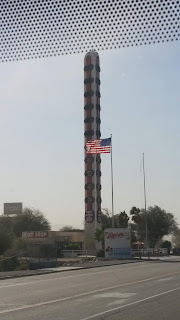From Pahrump, it was quite the drive to Red Canyon Conservation Area. Part of the reason was road construction about halfway there. The other was that it was about 45-50 miles! We were pleasantly surprised when we arrived. There was a nice visitor center with many outdoor activities. Bob found a friend to rest with after viewing about half of the center.
The conservation area is run by BLM (Bureau of Land Management). There is a 13 mile scenic drive through the area. The first stop on the drive is Calico Rocks. The name comes from the color of the rocks--mostly red and yellow. There is a hiking trail around the base of the rocks. This area is really crowded with tourists from all over the world.
At each stop along the drive there are several options for hiking. Bob and I chose Ice Box Canyon. The first reason was because of the cool name. The second was that it was farther along the drive and we hoped there wouldn't be as many people stopping to hike!
This is the start of the trail. The trail goes into the canyon behind Bob. From the parking lot it is a bit of a climb, but nothing compared to the end!
As we entered the canyon, the temperature dropped about 5 degrees. It felt good after being out in the sun.
The sun was shining just right to illuminate this tree on canyon wall.
Yes, this trail also involved scampering over rocks--more like boulders on this trail, especially near the end.
It was quite the view looking back out toward the entrance to the canyon.
The hike was good and there weren't too many hikers on this trail. We didn't go all the way into the back of the canyon as we were scheduled to attend a social at Pair-A-Dice and it was going to take time to get back.We got pretty close to the end of the trail. according to two college students we met coming back. We will check it out the next time we are in the area.
Once back in Pahrump, we met with other campers and compared camping stories. Most of the people we talked to were full-timers. Many of them liked to hike and told us of other places to visit.
The following day we decided to ride toward Death Valley Junction. It might as well have been a ghost town--there wasn't much there. On the way we passed the entrance to Ash Meadows Wildlife Refuge. On our return trip, we decided to check it out. It was another nice surprise! The visitor center was relatively new and very informative. Behind the visitor center was a boardwalk that led to a spring.
The gorgeous springs were filled with warm water and pupfish! Each spring had a pupfish population endemic to that spring.
We enjoyed watching the water bubble from the bottom of the spring, as well as watching the pupfish darting around the alga.
The springs are located in the desert! In this refuge, there are at least 7 springs.
This cabin belonged to quite the character in the late 1800s, early 1900s. It is built into the rock formed by minerals deposited by the spring. The back wall was the mineral wall!
Near this cabin was another spring. It is being restored since it was used for farming at one time. Farming lowers the sides of the basin allowing more invasive plants to survive.
To get to and from the cabin, you had to pass this beehive. The orange is NOT the hive, it is to the right of the orange growth. The bees were active, but they didn't mind us passing by.
Our last stop in Ash Meadows was actually a small portion of Death Valley National Park. The spring in this area is in a cave.
In the 1960s two divers who shouldn't have been in the cave drowned. Now the cave it fenced off and has many seismic detectors, water level monitors, etc. Scientists monitor water quality and they count the pupfish endemic to Devil's Hole.
It is difficult to see the water, it is just inside the entrance to the cave. The fish live on an underwater rock shelf just inside.
There is a back entrance to the cave about .15 miles from the first entrance. It is also protected. Try as we might, we couldn't see the water at this entrance.
We could walk all around the cage, but no place offered us a good view.
After a pleasant visit to Ash Meadows, it was time to head back to Pahrump and decide our next plan of action.























































